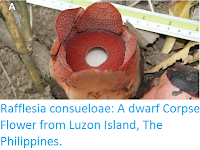Thismias (Thismiaceae) are a small group of Parasitic Plants found
throughout the tropics, with a few temperate species known from North
America, Japan, New Zealand and Australia. They parasitise the
Mycorrhizal Fungi with which all vascular plants have a relationship,
but where other plants exchange sugars produced by photosynthesis for
nutrients obtained from the soil by the Fungi, Thismias do not
photosynthesise, instead taking both nutrients and sugars from the Fungi
and giving nothing in return. In order to do this Thismias must target
Fungi in relationships with other Plants (since Fungi do not produce
sugars), preventing the Thismia from growing to any great size. Thismias
are related to Bat Flowers and Arrowroots; they were formerly
classified within the (also parasitic) Burmanniaceae, but it is now
recognised that while the two groups are fairly closely related, both
are more closely related to some non-parasitic plants than they are to
each-other.
In a paper published in the journal Taiwania on 24 June 2019, Sahut Chantanaorrapint of the Department of Biology at Prince of Songkla University, Naiyana Tetsana of the Forest Herbarium of the Department of National Parks, Wildlife and Plant Conservation, Petch Tripetch of Muang, and Somran Suddee, also of the Forest Herbarium of the Department of National Parks, Wildlife and Plant Conservation, describe a new species of Thismia from the Phu Hin Rong Kla and Phu Suan Sai national parks in northern Thialand.
The new species is named Thismia submucronata, where 'submucronata' meaning 'short-tipped'. The plant is whitish (it does not produce chlorophyll) with white flowers with darker bases, and small, triangular, scale-like leaves. It reaches about 14 cm in height. The species was found growing in two different locations, in both places growing in leaf litter, under the shade of moist evergreen forest, near a waterfall or stream side. The plants were found at altitudes of between 1200 and 1300 m.
Thismia submucronata, plant in natural habitat. Sahut Chantanaorrapint in Chantanaorrapint et al. (2019).
See also...
Follow Sciency Thoughts on
Facebook.







